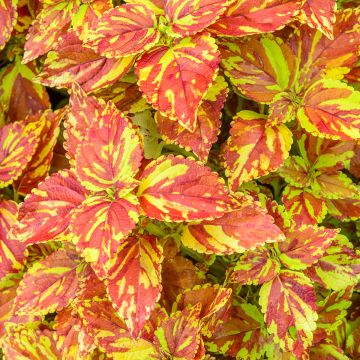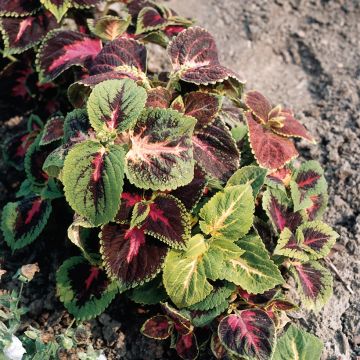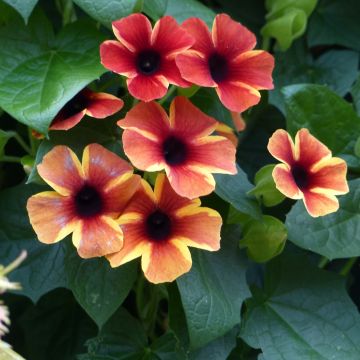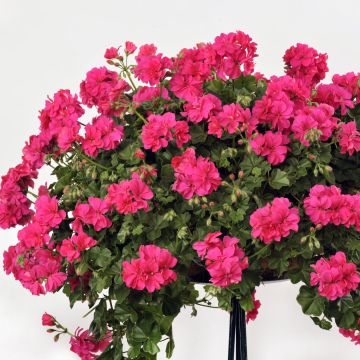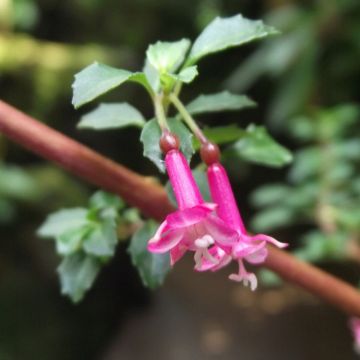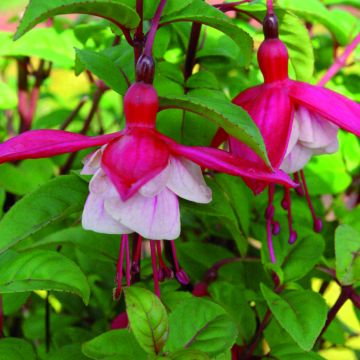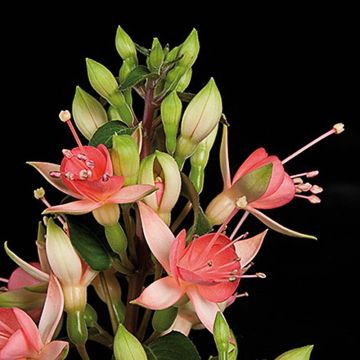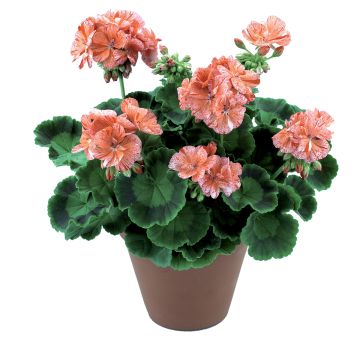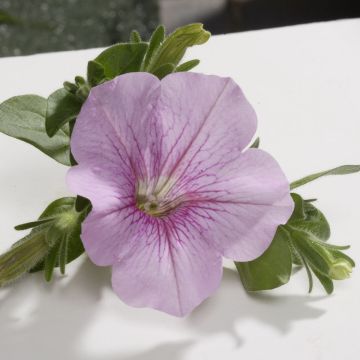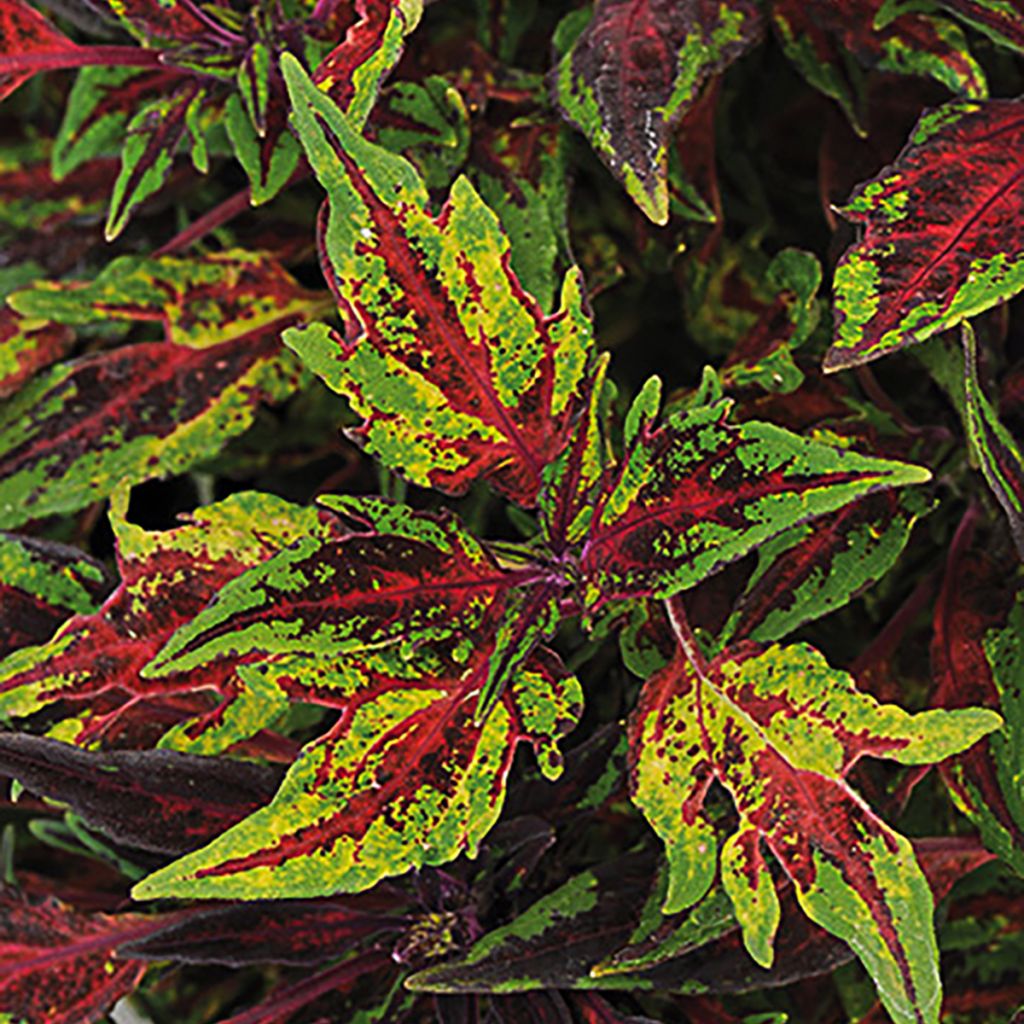

Coleus Chilli Pepper
Coleus Chilli Pepper
Coleus scutellarioides Chili Pepper
Coleus, Painted Nettle, Flame Nettle
This item cannot be shipped to the selected country
Delivery charge from €5.90
More information
Schedule delivery date,
and select date in basket
This plant carries a 6 months recovery warranty
More information
We guarantee the quality of our plants for a full growing cycle, and will replace at our expense any plant that fails to recover under normal climatic and planting conditions.
From €5.90 for pickup delivery and €6.90 for home delivery
Express home delivery from €8.90.
Does this plant fit my garden?
Set up your Plantfit profile →
Description
The Coleus Flame Thrower 'Chilli Pepper' forms an upright and dense clump of decorative foliage. Its serrated leaves are remarkably coloured: red and burgundy with green edges. It rarely flowers and requires little maintenance. Frost-sensitive, your coleus will thrive in both sun and shade in a flower bed or container. It can also be grown as an indoor plant.
Coléus, also known as Solenostemon or Plectranthus, belong to the Lamiaceae family, like basil. They share the same bilabiate flowers with elongated lower lips and square-section stems. While basil offers us aromatic leaves, coleus catches our attention with its decorative foliage. This genus comprises about sixty non-hardy shrubby perennials native to Asia and tropical Africa. Today, there are numerous hybrids and cultivars, always more remarkable, such as the Chili Pepper variety of the Flame Thrower series, selected for its ornamental qualities and ease of cultivation.
The 'Flame Thrower Chili Pepper' Coleus has a dense and well-branched habit from the base and does not exceed 45 cm (18in) in all directions in one season. Its leaves are beautifully serrated along the edges and slightly fuzzy. The central veins are tinted red and bordered by purple, and the lamina is edged green. Flowering is rare in this selection. The inconspicuous flowers sometimes appear in late summer. Remove them to prevent the plant from becoming exhausted and to enjoy its foliage fully.
Coleus, also known as 'painted nettle' due to their remarkably coloured foliage, find their place in a flower bed, border, or container. Grow them as indoor plants and enjoy their foliage for several years—Opt for the Switzerland begonia, with red flowers in a container, for a successful combination. Indeed, the vividly coloured foliage of the 'Flame Thrower Chili Pepper' Coleus makes it challenging to pair. To accompany it in a flower bed, the fern Polypodium Whitley Giant will create a sensation in the shad. At the same time, the Anabel Snow White lobelia prefers the sun or partial shade.
Note: Please be aware that our young plug plants are professional products reserved for experienced gardeners. Upon receipt, transplant them in containers, flower boxes, or flower beds as soon as possible.
Report an error about the product description
Flowering
Foliage
Plant habit
Botanical data
Coleus
scutellarioides
Chili Pepper
Lamiaceae
Coleus, Painted Nettle, Flame Nettle
Cultivar or hybrid
Other Coleus
Planting and care
Coleus Flame Thrower 'Chilli Pepper' is an easy-to-grow plant that tolerates sun and shade. Plant them after the last frost, sheltered from the wind. Avoid hot sun, however. Soil should be light and moist but well drained. Your coleus will also do well in a pot, so water regularly without letting the water stagnate in the dish. Add a little liquid fertiliser every fortnight from June to September. Remove the flowers as soon as they appear to prolong the plant's life. Usually grown as an annual, it is, in fact, a winter hardy perennial: by bringing it in at the first frost, you can extend its life for a few years and grow it as a houseplant. It can survive the winter in mild seaside climates by mulching well and then pruning lightly in March, ready for a new season.
Planting period
Intended location
Care
This item has not been reviewed yet - be the first to leave a review about it.
Plug plants - Annuals
Haven't found what you were looking for?
Hardiness is the lowest winter temperature a plant can endure without suffering serious damage or even dying. However, hardiness is affected by location (a sheltered area, such as a patio), protection (winter cover) and soil type (hardiness is improved by well-drained soil).

Photo Sharing Terms & Conditions
In order to encourage gardeners to interact and share their experiences, Promesse de fleurs offers various media enabling content to be uploaded onto its Site - in particular via the ‘Photo sharing’ module.
The User agrees to refrain from:
- Posting any content that is illegal, prejudicial, insulting, racist, inciteful to hatred, revisionist, contrary to public decency, that infringes on privacy or on the privacy rights of third parties, in particular the publicity rights of persons and goods, intellectual property rights, or the right to privacy.
- Submitting content on behalf of a third party;
- Impersonate the identity of a third party and/or publish any personal information about a third party;
In general, the User undertakes to refrain from any unethical behaviour.
All Content (in particular text, comments, files, images, photos, videos, creative works, etc.), which may be subject to property or intellectual property rights, image or other private rights, shall remain the property of the User, subject to the limited rights granted by the terms of the licence granted by Promesse de fleurs as stated below. Users are at liberty to publish or not to publish such Content on the Site, notably via the ‘Photo Sharing’ facility, and accept that this Content shall be made public and freely accessible, notably on the Internet.
Users further acknowledge, undertake to have ,and guarantee that they hold all necessary rights and permissions to publish such material on the Site, in particular with regard to the legislation in force pertaining to any privacy, property, intellectual property, image, or contractual rights, or rights of any other nature. By publishing such Content on the Site, Users acknowledge accepting full liability as publishers of the Content within the meaning of the law, and grant Promesse de fleurs, free of charge, an inclusive, worldwide licence for the said Content for the entire duration of its publication, including all reproduction, representation, up/downloading, displaying, performing, transmission, and storage rights.
Users also grant permission for their name to be linked to the Content and accept that this link may not always be made available.
By engaging in posting material, Users consent to their Content becoming automatically accessible on the Internet, in particular on other sites and/or blogs and/or web pages of the Promesse de fleurs site, including in particular social pages and the Promesse de fleurs catalogue.
Users may secure the removal of entrusted content free of charge by issuing a simple request via our contact form.
The flowering period indicated on our website applies to countries and regions located in USDA zone 8 (France, the United Kingdom, Ireland, the Netherlands, etc.)
It will vary according to where you live:
- In zones 9 to 10 (Italy, Spain, Greece, etc.), flowering will occur about 2 to 4 weeks earlier.
- In zones 6 to 7 (Germany, Poland, Slovenia, and lower mountainous regions), flowering will be delayed by 2 to 3 weeks.
- In zone 5 (Central Europe, Scandinavia), blooming will be delayed by 3 to 5 weeks.
In temperate climates, pruning of spring-flowering shrubs (forsythia, spireas, etc.) should be done just after flowering.
Pruning of summer-flowering shrubs (Indian Lilac, Perovskia, etc.) can be done in winter or spring.
In cold regions as well as with frost-sensitive plants, avoid pruning too early when severe frosts may still occur.
The planting period indicated on our website applies to countries and regions located in USDA zone 8 (France, United Kingdom, Ireland, Netherlands).
It will vary according to where you live:
- In Mediterranean zones (Marseille, Madrid, Milan, etc.), autumn and winter are the best planting periods.
- In continental zones (Strasbourg, Munich, Vienna, etc.), delay planting by 2 to 3 weeks in spring and bring it forward by 2 to 4 weeks in autumn.
- In mountainous regions (the Alps, Pyrenees, Carpathians, etc.), it is best to plant in late spring (May-June) or late summer (August-September).
The harvesting period indicated on our website applies to countries and regions in USDA zone 8 (France, England, Ireland, the Netherlands).
In colder areas (Scandinavia, Poland, Austria...) fruit and vegetable harvests are likely to be delayed by 3-4 weeks.
In warmer areas (Italy, Spain, Greece, etc.), harvesting will probably take place earlier, depending on weather conditions.
The sowing periods indicated on our website apply to countries and regions within USDA Zone 8 (France, UK, Ireland, Netherlands).
In colder areas (Scandinavia, Poland, Austria...), delay any outdoor sowing by 3-4 weeks, or sow under glass.
In warmer climes (Italy, Spain, Greece, etc.), bring outdoor sowing forward by a few weeks.


































